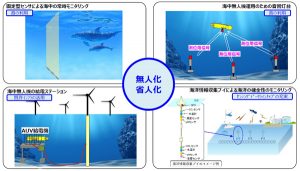Environmental conservation and effective use of resources with underwater acoustic technology OKI’s marine data infrastructure utilization service

OKI has set the preservation of the global environment as one of its goals in its group’s “Medium-term Management Plan 2025”. As part of this effort, we are promoting “environmental conservation and resource utilization through ocean visualization”. Utilizing the company’s strengths in sensor technology, underwater acoustic processing technology, submarine cable laying, and information processing technology, OKI aims to build underwater infrastructure and provide marine data infrastructure utilization services necessary for marine resource development and marine infrastructure conservation.
Kei Uemura, general manager of the company’s special equipment systems division, said, “Currently, the marine industry, including ports, shipbuilding, and CCS (carbon dioxide capture and storage), is becoming more active. Various problems such as overfishing are becoming apparent.By applying underwater acoustic technology, which we have cultivated over many years in defense systems, to visualize the ocean, we can contribute to environmental conservation and effective use of resources.”
The company has a three-step growth strategy. Step 1 is to participate in research and development projects and make the OKI brand known. The company’s technological capabilities will be made known by participating in national projects (government research and development projects).
Step 2 is to practice ocean monitoring, research on ocean monitoring technology, and enrich the product lineup. Step 3 aims to implement ocean monitoring in society and provide added value through ocean data platforms.
The goal is to achieve Step 1 by 2025, Step 2 by 2028, and Step 3 by 2031.
Technical points include the use of sound in the development of underwater parts such as underwater infrastructure, sensors, and networks, utilization of existing infrastructure, and enrichment of the sensing data lineup.
Mr. Uemura explains, “In the ocean, we need underwater infrastructure, sensing platforms, and the underwater network that connects them.And on land, we need a database system to accumulate sensor data and analysis software to visualize the ocean”.
The key to infrastructure construction is unmanned technology. The company plans to enable its sensing platform to collect underwater data without human intervention.
“For example, in border surveillance, we use sound to understand what is passing through the ocean.Also, in the future, there will be more unmanned vehicles operating underwater, so we are developing something like underwater GPS, which allows unmanned vehicles to operate without human intervention. “We would like to realize technology for operating the robot using sound. Development of offshore wind power generation is currently progressing, and we are also planning to use the electricity generated offshore to build a power supply station for unmanned aircraft” (Mr. Uemura).
In addition, an offshore buoy will be required to transmit the data acquired underwater to land. They are also considering installing various sensors on the buoy to visualize the ocean.
Since it is difficult for light and radio waves to reach the ocean, technology that utilizes sound is important for long-distance communication.
OKI has been developing underwater acoustic communications for unmanned aerial vehicles since 2020. Key points of development are “Doppler resistance (10 kt) to match the movement of underwater unmanned vehicles”, “multipath resistance in small size (1 m or less)”, “1-to-N communication assuming multiple simultaneous use”, and “multi-hop communication”.

海洋インフラのポイント(Image of marine infrastructure)
Although progress has already been made in vertical communication using sound waves from ships to drones, horizontal communication between drones is a challenging area.
The company is proceeding with development with a view to realizing horizontal communication. If this becomes a reality, it will be possible to carry out safe and wide-ranging underwater operations using multiple unmanned aircraft.
The business image is to accumulate sensing ocean data and provide it as basic data to research institutes researching global warming, fishermen, and aquaculture companies, use in O&M of offshore wind power generators, and monitoring CCS , earthquake monitoring, etc.
Hiroshi Tanabe, deputy general manager of the company’s special equipment systems division, said, “Our concept is grand, and it would be difficult for us to realize it alone.Therefore, we would like to develop it in collaboration with companies, universities, and local governments with an open innovation orientation. We also want to focus on training young Japanese engineers for the sustainable development of marine technology”.
